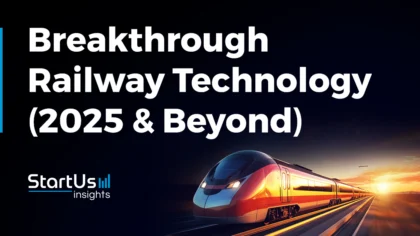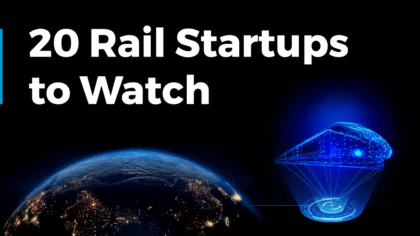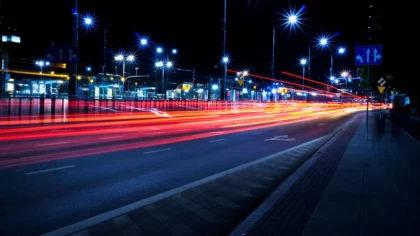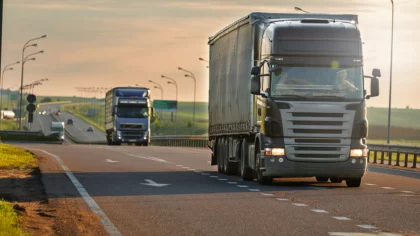The railway industry is transforming as emerging technologies reshape infrastructure design, operation, and maintenance. Typical challenges like aging infrastructure, safety concerns, and rising operational costs are being addressed through advancements in 3D printing, AI, digital twin solutions, and robotics. Moreover, the strategic use of big data and analytics, enhanced cybersecurity measures, and cleantech solutions, enable the industry to optimize resources and reduce environmental impact. Meanwhile, cloud computing, connectivity, and the internet of things (IoT) improve communication and operational efficiency. Railway technology startups are leading the charge in this technological shift.
For example, TheCrossProduct develops AI-powered 3D Lidar systems for rail infrastructures and NXTGEN Industries offers autonomous railway inspection and train examination systems. To stay competitive, railway companies must embrace these advancements and integrate them into their long-term strategies.
Why should you read this report?
- Gain in-depth insights into the top 10 technologies impacting railway.
- Learn about three practical use cases for each technology.
- Meet 10 innovative startups advancing these technologies.

Key Takeaways
- Additive Manufacturing
- Use Cases:
- Custom Spare Parts Production
- Lightweight Components Manufacturing
- Obsolete Components Fabrication
- Startup to Watch: Replique
- Use Cases:
- Artificial Intelligence (AI)
- Use Cases:
- Real-time Fault Prediction
- Optimized Scheduling
- Automated Inspections
- Startup to Watch: supplai
- Use Cases:
- Digital Twin
- Use Cases:
- Reducing Downtime
- Infrastructure Management
- Optimized Rail Scheduling
- Startup to Watch: TheCrossProduct
- Use Cases:
- Big Data & Analytics
- Use Cases:
- Preemptive Equipment Management
- Real-time Operation Monitoring
- Passenger Experience
- Startup to Watch: Lenz Labs
- Use Cases:
- Cybersecurity
- Use Cases:
- Protection of Control Systems
- Passenger Data Security
- Real-time Threat Detection
- Startup to Watch: Shift5
- Use Cases:
- CleanTech
- Use Cases:
- Hydrogen Fuel Cell Trains
- Regenerative Braking Systems
- Solar-powered Rail Infrastructure
- Startup to Watch: SWS Power Solutions
- Use Cases:
- Cloud Computing
- Use Cases:
- Disaster Recovery
- Ticketing and Reservation Monitoring
- Real-time Train Monitoring
- Startup to Watch: Praedico
- Use Cases:
- Connectivity Technologies
- Use Cases:
- Advanced Signalling Systems
- Smart Stations
- Vehicle-to-Everything Communication
- Startup to Watch: United ECM
- Use Cases:
- Internet of Things (IoT)
- Use Cases:
- Smart Maintenance
- Energy Management
- Passenger Experience Enhancement
- Startup to Watch: Cnection
- Use Cases:
- Advanced Robotics
- Use Cases:
- Autonomous Inspection & Maintenance
- Robotic Welding and Repair Systems
- Autonomous Train Operations
- Startup to Watch: NXTGEN Industries
- Use Cases:
- Additive Manufacturing
Railway Industry FAQs
How much is the railroad industry worth?
The railroad industry was valued at around USD 296.88 billion in 2023 and is projected to reach USD 436.35 billion by 2030, with a compound annual growth rate (CAGR) of 5.6%. The rising investments in passenger and freight rail services, especially in emerging markets like Asia-Pacific, drive this growth.
How can the railroad industry use technology?
Technology in the railroad industry transforms operations by introducing solutions such as the Internet of Things (IoT), autonomous rail vehicles, and big data analytics. These technologies improve train safety, optimize routing, enhance maintenance schedules, and provide real-time monitoring of train conditions. Additionally, the electrification of rail networks increases, particularly in regions like Europe and Japan, leading to reduced carbon emissions and improved energy efficiency.
How does railroad technology improve profits for companies?
Railroad companies leverage AI-driven predictive maintenance to reduce operational disruptions and costly repairs. The automation of functions such as ticketing and freight handling improves operational efficiency, leading to lower costs and faster service delivery. Further, investments in high-speed rail networks are expected to attract more passengers, increasing revenue.
Where We Get Our Data From
StartUs Insights gathers data through its exhaustive Discovery Platform, covering information on 4.7 million startups, scaleups, and tech companies globally, alongside 20,000 emerging technologies and trends. The Discovery Platform accelerates startup and technology scouting, trend intelligence, and patent searches, offering thorough insights into technological advancements. By leveraging the trend intelligence feature for this report, we identified emerging technologies within specific industries. This process allows us to uncover patterns and trends, and pinpoint relevant use cases and the startups creating solutions for each scenario. Additional capabilities and information can be found at StartUs Insights Discovery Platform.
10 Emerging Technologies Impacting the Future of Railway [2025 & Beyond]
1. Additive Manufacturing

Driven by the need for sustainable and efficient manufacturing, 3D printing reduces lead times, minimizes waste, and creates complex parts on demand. This technology uses techniques like fused deposition modeling (FDM) for plastic prototypes, selective laser melting (SLM), and stereolithography (SLA) for high-strength, heat-resistant custom spare parts. It also employs direct metal laser sintering (DMLS) for intricate, lightweight components. These methods reduce operational costs, improve maintenance, and support the industry’s shift toward zero emissions by cutting material waste and energy consumption.
3 Practical Use Cases of Additive Manufacturing in Railway
- Custom Spare Parts Production: Rapid production of custom spare parts involves modifying existing designs to meet specific requirements, such as changes in dimensions, material, or functionality. This reduces the need for large inventories, leading to cost savings and more efficient maintenance.
- Lightweight Components Manufacturing: Topology optimization and selecting materials like carbon fiber reinforced polymers and 3D printing technologies create lightweight, durable parts like metal brackets and connectors. These components improve fuel efficiency and reduce overall train weight, contributing to lower energy consumption.
- Obsolete Components Fabrication: 3D scanning of an existing part and selecting the appropriate material for 3D printing allows for the fabrication of components. This allow rail companies to maintain aging infrastructure efficiently, reducing downtime risks, and enhancing service reliability.
Startup to Watch: Replique
German startup Replique offers a digital platform for on-demand 3D printing of train parts. The solution digitizes parts and stores them in a secure digital inventory that allows production anytime through a decentralized network of certified 3D printers. This eliminates the need for physical inventories and minimum order quantities to ensure parts are produced and delivered only when needed. Replique integrates industrial materials and patented quality assurance processes to provide a flexible solution for rail operators needing spare and custom parts.
2. Artificial Intelligence

AI uses sensor data to predict equipment failures and runs algorithms to optimize train schedules. It addresses challenges like reducing downtime and optimizing maintenance schedules by leveraging neural networks for fault detection and metaheuristics for maintenance optimization. These technologies are deployed in track monitoring systems and rolling stock maintenance to enhance safety and reduce operational costs.
3 Practical Use Cases of Artificial Intelligence in Railway
- Real-Time Fault Prediction: Rail companies use AI to monitor rail track conditions in real time by collecting data from sensors and environmental sources. It integrates this data to predict faults, reduce downtime, enhance safety, and lower repair costs by addressing issues early.
- Optimized Scheduling: Machine learning algorithms analyze passenger flow and operational data to optimize train schedules based on resource availability. It develops models tested through simulated scenarios to reduce delays and improve service reliability.
- Automated Inspections: AI-powered systems, including robotics, drones, and sensors, automate inspections of rail infrastructure through pattern recognition and image analysis. This speeds up the process, ensures timely maintenance, and improves the safety and longevity of rail assets.
Startup to Watch: supplai
Dutch startup supplai offers an AI-powered solution, Rail OCR for rail industries to automate various processes. The system uses optical character recognition (OCR) for railcars, automatic equipment identification (AEI), and automated gate systems (AGS), to process data without traditional line-scan cameras. supplai integrates with terminal management systems and scales for cloud-based or on-premises deployments. Its online platform continuously trains algorithms to enhance operational efficiency, automate data collection, and reduce manual input errors.
3. Digital Twin

The railroad industry is adopting digital twins to enhance operational efficiency, predictive maintenance, and safety. Digital twin technology addresses unexpected equipment failures, operational inefficiencies, and stringent regulatory requirements. By integrating IoT sensors for real-time asset monitoring, AI for predictive maintenance, and cloud computing for data processing, digital twins provide railroads with powerful tools. These technologies improve train scheduling, reduce maintenance costs, and enhance safety through real-time simulations and proactive decision-making.
3 Practical Use Cases of Digital Twin in Railway
- Reducing Downtime: Digital twin-based systems monitor train components like wheels and brakes using IoT sensors. Real-time data analysis predicts maintenance needs, prevents breakdowns, and reduces downtime. This ensures smoother train operations.
- Infrastructure Management: Combining building information modeling (BIM) and geographic information systems (GIS) digital twins aid in managing rail infrastructure. This integration provides a detailed view of assets, aiding in planning, construction, and maintenance, optimizing asset management.
- Optimized Rail Scheduling: Using simulation and AI tools, digital twin solutions optimize train schedules. By modeling various scenarios like weather and passenger flow, they identify efficient schedules, reducing delays and improving overall operational efficiency.
Startup to Watch: TheCrossProduct
French startup TheCrossProduct develops software that automates scanning vast areas to generate precise 3D digital twins for infrastructure like rails, lanes, and cables. The software uses 3D LiDAR technology and AI to assess safety distances, detect collision risks, and perform reverse engineering. It processes point clouds in various formats (e.g., LAS, LAZ, e57) and converts them into 3D polylines for integration with GIS or BIM applications. TheCrossProduct’s solution also conducts comprehensive railway gauge studies to ensure compatibility with infrastructure, enhancing predictive and corrective maintenance with precise insights.
4. Big Data & Analytics

Key big data technologies include advanced data analytics platforms like High Performance Computing Clusters (HPCC) Systems offer real-time analysis and security features for the rail industry. Integrated systems such as cyber-physical systems, IoT, and cloud computing enable communication between railway assets. Further, smart sensors gather large volumes of data for infrastructure monitoring, aiding predictive maintenance and asset management. These advancements improve decision-making and optimize the lifecycle of railway assets.
3 Practical Use Cases of Big Data & Analytics in Railway
- Preemptive Equipment Management: Analyzes IoT sensor data from trains and tracks to predict equipment failures and perform early maintenance. This reduces downtime and optimizes repair schedules.
- Real-Time Operation Monitoring: Allows immediate response to issues like delays or equipment malfunctions. This ensures smoother operations and enhances service reliability for passengers and freight.
- Passenger Experience: Analyzes passenger data from ticketing, travel patterns, and demographics to improve service, optimize pricing, and personalize travel experiences to imrpove customer satisfaction.
Startup to Watch: Lenz Labs
UK-based startup Lenz Lab develops a network mapping platform to optimize rail maintenance and logistics management. The platform allows visualization, planning, and reporting on seasonal treatment to address weather-induced low-adhesion conditions that affect train braking and acceleration. It also supports asset inspections to ensure signals and power systems remain operational through periodic reviews. Further, the Lenz Lab’s platform streamlines delay attribution to aid managers in reviewing historical incidents and delays to generate reports and understand their financial impact.
5. Cybersecurity

As rail systems integrate IoT, AI, and cloud technologies, the industry faces increased vulnerabilities to cyber threats. Cybersecurity solutions protect critical infrastructure from unauthorized access, ensures operational data integrity, and maintains regulatory compliance. Coupled with enabling technologies, cybersecurity drives innovations like encryption for secure data transmissions, AI and machine learning for real-time threat detection, and blockchain for tamper-proof transaction records.
3 Practical Use Cases of Cybersecurity in Railway
- Protection of Control Systems: Firewalls, intrusion detection systems (IDS), and secure communication protocols like TLS/SSL protect train control systems. SCADA security solutions and real-time monitoring tools prevent unauthorized access, ensuring operational safety and preventing disruptions.
- Passenger Data Security: Encryption techniques (AES, RSA) and multi-factor authentication (MFA) secure passenger data. Secure payment gateways and Identity and Access Management (IAM) systems protect sensitive information to reduce the risk of identity theft and fraud.
- Real-Time Threat Detection: Anomaly detection and behavioral analysis identify threats in real-time. SIEM systems and AI-powered platforms monitor and respond to unusual activities to prevent potential cyberattacks and maintain continuous, secure railroad operations.
Startup to Watch: Shift5
US-based startup Shift5 develops an observability platform for onboard operational technology (OT) to provide real-time data access, contextual insights, and actionable analytics for the aerospace, rail, and defense industries. The platform captures and analyzes serial bus data and offers features like predictive maintenance, cybersecurity threat detection, and compliance monitoring. The startup enhances cybersecurity by delivering continuous monitoring and protection against cyber threats targeting OT systems. Shift5 provides operational and cybersecurity teams with comprehensive data visibility and decision intelligence to protect and optimize fleet performance.
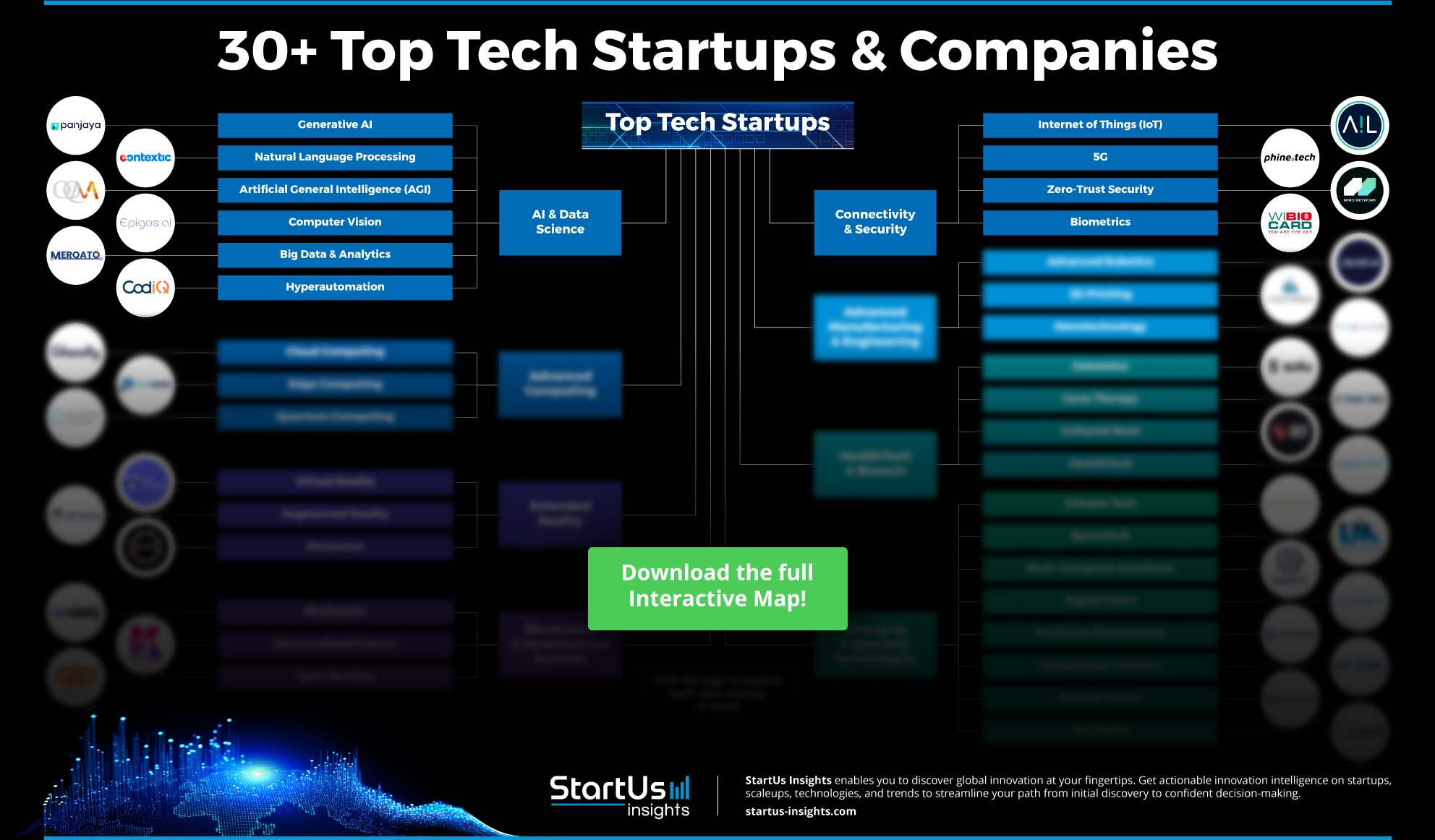
6. CleanTech

As regulatory pressure and demand for green solutions grow, cleantech addresses high carbon emissions and improves energy efficiency. Rail companies are integrating innovations like hydrogen fuel cells for zero-emission trains, regenerative braking systems for energy recovery, and lightweight materials like carbon fiber to reduce energy consumption. These solutions lower operational costs and improve environmental performance across rail networks.
3 Practical Use Cases of CleanTech in Railway
- Hydrogen Fuel Cell Trains: These trains generate electricity by combining hydrogen and oxygen, emitting only water vapor. This railroad tech replaces diesel engines on non-electrified routes to reduce greenhouse gas emissions and improve air quality.
- Regenerative Braking Systems: Converts a train’s kinetic energy into electrical energy during deceleration and stores it in batteries or feeds it back into the grid. It reduces overall energy consumption and reliance on external power sources.
- Solar-powered Rail Infrastructure: Solar panels installed alongside rail tracks or on stations convert sunlight into electricity to power station operations, signaling systems, lighting, and even train charging.
Startup to Watch: SWS Power Solutions
Austrian startup SWS Power Solutions builds SWS-PowerBox, a climate-neutral energy solution for cooling units on rail freight wagons. This device uses advanced lithium-ion battery technology for sustainable, emission-free operations. The SWS-PowerBox offers an autonomous energy supply, supports remote monitoring and diagnostics, and is designed for efficient energy management even under extreme conditions. Its key features include modular design, and fast recharging that ensures reliable, eco-friendly power for temperature-sensitive logistics.
7. Cloud Computing

Technologies like AWS Cloud, Microsoft Azure, and open cloud systems offer the rail sector platforms for managing and analyzing large data sets. These solutions improve system reliability, improve operational resilience, and cut costs by reducing the need for on-premises infrastructure. Cloud computing also enhances collaboration by breaking down data silos to enable real-time information sharing among stakeholders. Integrating broadband communications with cloud technology supports predictive maintenance and intelligent video surveillance that allows rail operators to optimize performance and safety.
3 Practical Use Cases of Cloud Computing in Railway
- Disaster recovery: Cloud computing provides disaster recovery by backing up critical railway data to ensure quick restoration in case of system failures or cyber-attacks. It reduces the risk of data loss and ensures operational continuity.
- Ticketing and reservation system: Cloud platforms host scalable ticketing systems using microservices architecture and real-time analytics. This improves performance during peak travel times, offers personalized customer experiences, and reduces operational costs.
- Real-Time Train Monitoring: Centralized management of scheduling, train dispatching, and resource allocation through real-time monitoring of trains using GPS and IoT. Advanced analytics on platforms like Azure or Google Cloud optimize schedules, reduce delays, and improve passenger safety with real-time alerts.
Startup to Watch: Praedico
Dutch startup Praedico develops cloud computing software to optimize light and heavy-haul network operations by centralizing and digitizing rail data for smart asset management. The platform uses big data and AI algorithms to predict potential defects, improve track availability, and reduce maintenance costs. It offers a comprehensive view of network health, assessing risks and performance using KPIs and deviation tracking. The startup provides features like high-resolution satellite imagery, GIS mapping, mobile accessibility, and streamlined ticketing to ensure informed decision-making, improving safety, reliability, and operational efficiency across rail networks. Further, Praedico enables rail modeling and scenario planning that allows rail operators to create simulations and projections to analyze different scenarios.
8. Connectivity Technologies

Connectivity technologies are modernizing railway operations by enhancing real-time communication, data transfer, and system reliability. Key technologies include 5G, which provides high-speed, low-latency communication for operational efficiency and passenger services. Integrating 5G with ethernet and time-sensitive networking (TSN) ensures deterministic data transmission with minimal delays, which are crucial for safety-critical applications. LoRaWAN supports long-range, low-power communications, for asset tracking and infrastructure monitoring in remote areas. Wi-Fi and private LTE networks are essential for onboard connectivity that enables internet access for passengers and improves operational communications across rail networks.
3 Practical Use Cases of Connectivity Technologies in Railway
- Advanced Signaling Systems: Communication-based train control (CBTC) and the European rail traffic management system (ERTMS) rely on continuous communication between trains and control centers. These systems improve the safety, reliability, and capacity of rail networks by enabling closer train spacing and more efficient traffic management.
- Smart Stations: Wi-Fi and wireless mesh networks in stations provide internet access, support digital ticketing, and enable real-time updates. These networks enhance passenger satisfaction through personalized services, improve operational efficiency, and support smart station initiatives.
- Vehicle-to-everything (V2X) communication: V2X technology allows trains to communicate with each other and with trackside infrastructure. This enhances collision avoidance systems, improves traffic management, and ensures more efficient use of rail networks. It is particularly useful in densely populated urban rail systems.
Startup to Watch: United ECM
US -based startup United ECM oversees the construction and maintenance of high-speed and electrified transit systems. It integrates expertise in traction power systems, overhead catenary systems, SCADA, and train control to ensure efficient transit system management. The company’s platform centralizes decision-making, offering rail operators a complete view of their infrastructure, including communication design and safety-critical systems. By combining field knowledge with design, including 3D BIM modeling, United ECM optimizes transit system reliability, safety, and efficiency which lets transit agencies manage complex projects and minimize operational disruptions.
9. Internet of Things

IoT is transforming the railway industry by connecting physical assets with digital platforms. Smart sensors, cellular IoT, and machine-to-machine (M2M) communication systems drive this change. IoT sensors in trains, tracks, and stations monitor conditions in real time to ensure continuous asset and infrastructure tracking. Advancements in computer vision and smart cameras improve safety by automating real-time incident alerts. Rail operators integrate these technologies to optimize maintenance schedules, improve operational efficiency, and enhance passenger safety and reliability.
3 Practical Use Cases of the Internet of Things in Railway
- Smart Maintenance: IoT sensors monitor critical train components such as wheels, brakes, and tracks, transmitting real-time data to a cloud-based analytics platform. This enables predictive maintenance by detecting potential failures early, reducing unplanned downtime, lowering maintenance costs, and enhancing safety through proactive issue resolution.
- Energy management: IoT devices monitor energy consumption in trains and rail infrastructure and provide data to optimize energy use and reduce costs. This is particularly relevant for electric trains, where energy efficiency is crucial. The rail operators adjust power usage dynamically based on real-time conditions for energy savings.
- Passenger Experience Enhancement: Real-time information on train schedules, delays, and platform changes is provided through connected devices and apps. Smart ticketing systems also streamline the boarding process, reducing wait times and improving overall service quality.
Startup to Watch: Cnection
UK-based startup Cnection offers RFID-based asset-tracking solutions for the rail sector. Its TrakStar MQ is a smart RFID reader for unattended asset management and process control, housed in a IP67 weatherproof enclosure. The TagSta Pro is an RFID tag programmer and reader that adheres to GS1 EPC/RFID standards and simplifies the programming process. Cnection also provides Network Rail Compliant UHF RFID Tags for automatic vehicle identification and a battery-less Smart UHF RF Meter for detecting RFID reader activity around the UHF Band 868MHz.
10. Advanced Robotics

Advanced robotic systems with autonomous arms perform tasks like welding and grinding on railway tracks with precision. These robots operate continuously to reduce human intervention in dangerous environments and minimize downtime. Cognitive analytics combined with robotics enhances decision-making that enables automated maintenance actions based on real-time data. Further, lightweight robots for inspection and light maintenance reduce costs while ensuring the safety of railway infrastructure. These innovative rail technologies address labor shortages and ensure the long-term reliability of rail networks.
3 Practical Use Cases of Advanced Robotics in Railway
- Autonomous Inspection and Maintenance Robots: Autonomous robots inspect rail infrastructure using LiDAR and cameras to detect cracks and misalignments. They transmit data via 5G for real-time analysis with AI, enhancing safety by minimizing human exposure to hazardous environments and improving inspection accuracy and speed.
- Robotic Welding and Repair Systems: Robotic arms with welding tools guided by computer vision perform precise welding and repairs in rail depots. Automation software manages these tasks to increase the consistency and speed of repairs while reducing the risk of accidents.
- Autonomous Train Operations: Robotics and AI enable autonomous train control, with sensors like LiDAR and radar ensuring safe operations by managing speed, braking, and obstacle detection.
Startup to Watch: NXTGEN Industries
Australian startup NXTGEN Industries develops ARIIS, an autonomous railway infrastructure inspection system, and T.R.E.S., an autonomous train examination system, to enhance rail network safety and efficiency. ARIIS uses high-resolution visuals, LiDAR, GPS, and laser tools to detect defects and enable targeted maintenance. It captures real-time data for faster inspections of track geometry and tunnels. T.R.E.S. uses a robotic arm, wireless communication, and cameras for comprehensive undercarriage inspections.
Outlook for the Railway Industry
Patents & Grants
Technological advancements drive significant changes in the rail industry, with over 30550 patents granted, and more than 2100 grants awarded, indicating strong innovation and research.
For more actionable insights, download our free Railway Innovation Report.
Investment Landscape
Investors such as EIT Urban Mobility, Kleiner Perkins, Y Combinator, 8VC, and Abstract Ventures support this technological transformation. The funding rounds include seed, early-stage VC/series A, accelerator/incubator, pre-seed, and angel investments that provide essential capital for innovations.
Global Footprint
Major hubs like the US, India, UK, Germany, and China, along with key cities such as London, Mumbai, New Delhi, New York City, and Bangalore, drive startup activity and innovation in the rail sector. These regions foster the industry’s growth and advancements.
Act Now to Take Advantage of Top Rail Technologies
Take immediate action on the top emerging rail tech to stay ahead in the industry. StartUs Insights empowers you to uncover hidden opportunities among 4.7 million startups and tech companies, alongside insights into 20,000 technologies and trends. Our AI-powered, real-time database provides unparalleled access to solutions that are not available elsewhere, ensuring you always lead in innovation.
Major companies like Samsung, Nestlé, and Magna rely on our tools to spearhead trends and optimize operations. “We appreciate working with StartUs Insights because of their team’s flexibility and commitment to serve our needs,” says Xabier Perez, Head of Technology Strategy Area, R&D Department at CAF. Dive into unmatched data like them and benefit from a 360-degree industry view for actionable insights. Get in touch with us now to discover how our innovation intelligence can elevate your strategic initiatives.
Discover All Rail Technologies & Startups!
